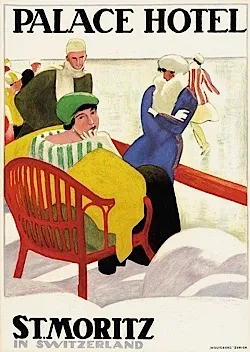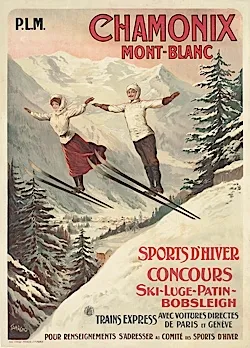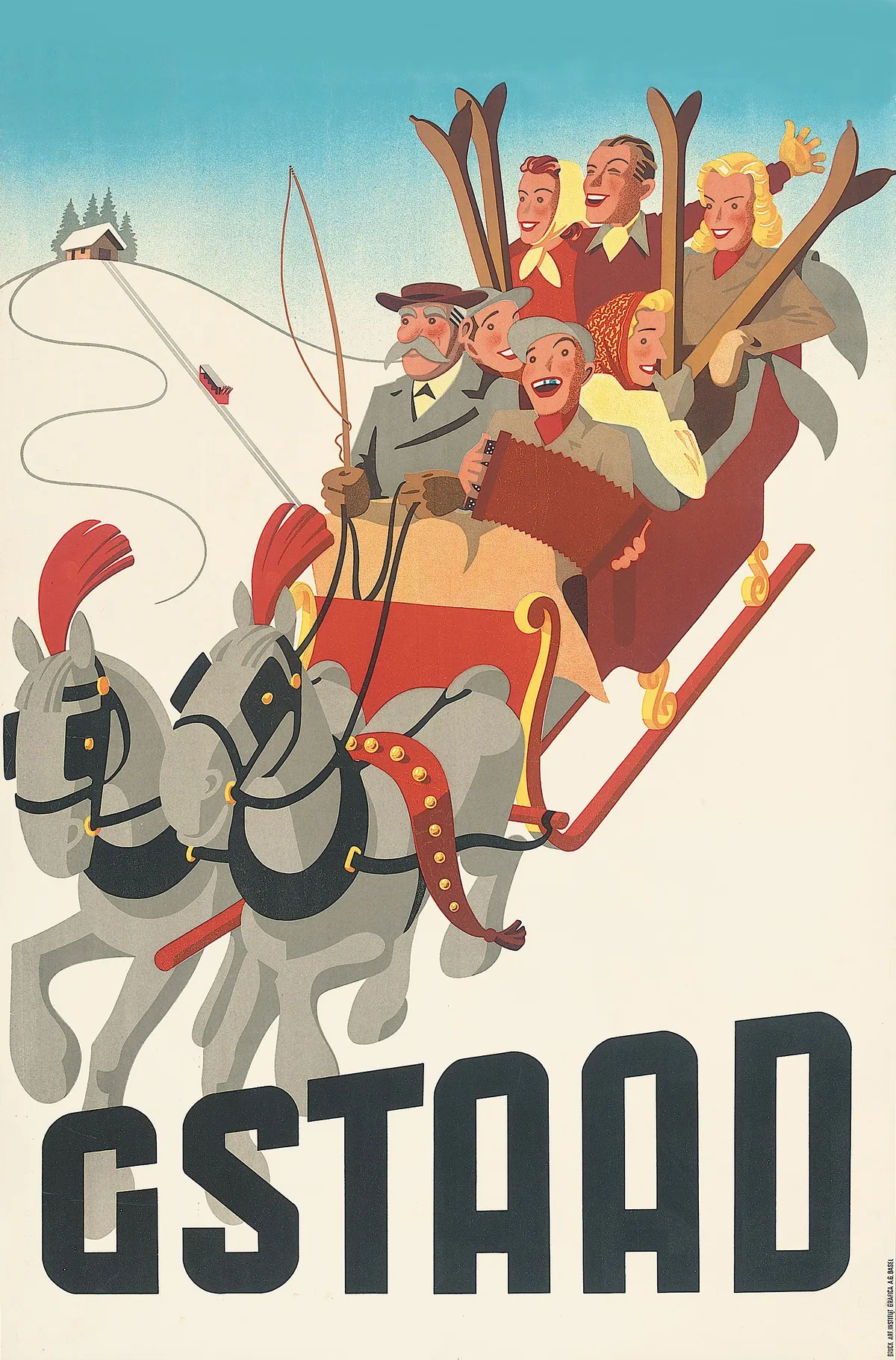Looking back at my school days, there is one memory that outshines all the others – my first ski trip. Cervinia, an Italian resort at the foot of the mighty Matterhorn, was my alpine base. I remember the excitement of getting up at dawn to start the journey that would lead us to the snow and, eventually, to the image etched in the mind’s eye of anyone who has skied – that panoramic, truly breathtaking view from the top of the mountain.

With subject matter so inherently captivating, it’s no wonder that ski posters have such a loyal following. Like most skiers, I’m the first to head for an image that promotes a resort I know – Cervinia, Verbier and the Trois Vallées are all personal favourites. Ten years ago when the market was in its infancy, I paid £300 for a 1940s poster full of flags, poles and a puffing French National Railways steam loco. Then, as now, it summed up all the romance of the sport, the thrill of the journey and my perpetual thoughts of a chocolat chaud!
When did skiing posters first appear?
Thanks to the discovery of what appears to be the first ski – carved in wood and around 8,000 years old - we know skiing has long been an essential part of human survival. But the notion of skiing for pleasure wasn’t truly formalised until the 19th century, when intrepid explorers took on death-defying challenges. In 1894, Sir Arthur Conan Doyle became an unlikely champion when he completed the world’s first ski tour, crossing the Alps near Davos. Dressed in Harris Tweed, he was accompanied by two brothers, who owned a local ski shop.
Wealthy Europeans who had read of such exploits were keen to have a taste of what the snow could offer. As more people travelled, villages grew into fashionable destinations and small hostels made way for luxurious hotels, many of which commissioned artists to design attractive posters. By 1908, rudimentary steam-powered drag lifts were replaced with electrically-driven cable cars; by 1910 ski clubs were established, and competitive downhill skiing and slalom racing was de rigeur. When the first Winter Olympics took place in Chamonix in 1924, the ‘Golden Age’ of skiing posters had begun.
Which were the first places to market themselves with posters?
Villages such as Davos, St Anton, Mürren and Wengen (at the heart of the new downhill and slalom racing) were quick to recognise the benefits of striking promotional posters. In many cases it was the grandest hotel in the resort that used posters to lure patrons in, although Europe’s competing railway firms were equally keen to ensure travellers went their way. Throughout the 1920s, France’s PLM (Paris Lyon Mediterranean railway) was at the forefront of promoting its destinations through posters, while the USA followed suit slightly later. In 1929, the New Haven Railroad ran the first ski train from New York’s Grand Central station to the newly-opened ski centres in New England.
When did skiing turn into a popular holiday option?
In 1930s Britian, the pioneering Viennese tour operator Erna Low led the first winter holiday tours to resorts in Austria,introducing a new breed of traveller – the package holidaymaker, albeit of the upper-middle class variety – to the Alps.
Your package, priced at £15 in 1932, included German lessons, ski hire and 10 days full board. Ski lift passes were not offered as there were no ski lifts at the destination – they were yet to come!
Ski posters were placed, as they are now, in Erna Low’s London headquarters to help travellers choose where to go.

Even in 1946 you had to be dedicated to get the most out of your skiing holiday. A break in Saas-Fee (a location described as ‘most attractive’) was offered for £35 5s (roughly two months’ salary). To get there, you had to do the three hour ascent ‘by foot or on a mule’. By the 1950s,
charter flights and weekly snow trains had improved the journey, while the creation of the chalet party (another Erna Low idea) transformed the experience.
Who were the big-name poster artists?
It’s no surprise to find that the artists who designed the most striking ski posters were often more than competent skiers themselves. Artists such as Emil Cardinaux (whose poster for the Palace Hotel, St Moritz, became the most expensive European ski poster ever sold when it fetched £23,900 at Christie’s in 2004), Burkhard Mangold, Hugo Laubi, Herbert Matter and Martin Peikert are all worth looking out for. American ski poster connoisseurs adore Sascha Maurer for the very same reason – his innate ability to capture the magic of the pistes.
The most highly regarded ski poster artist is Frenchman Roger Broders, known for his work with the PLM railway, which captured deco style so perfectly. His clean lines and bold colours took advertising images to new heights encapsulating, more than anything, the social aspect of a holiday on the slopes.
I’d love to buy a vintage poster – what are my options?
Launching into the ski poster market is easier than you might think. A good starting point is to focus on locations you have visited. After that, what you select is governed by how much you want to spend. These days, entry level is around £500 for a clean, undamaged design that dates from the 1950s or one of the as-yet unappreciated photographic posters from the 1970s. Posters for popular resorts tend to be the most expensive.
How can I be sure that my poster is an original?
To help with dating, study all your potential buys at close range. Ski Posters from the desirable deco years were printed using stone lithography, so they have large areas of flat colour, which gives the designs real depth.
Offset lithography, which came in after the war, is a photographic method of printing where the image is made up of tiny coloured dots, rather like a picture in a magazine.
Remember too that posters were never meant to last a lifetime – they were printed in large sizes on thin paper for pasting on billboards. Posters measuring 102 x 64cm or 127 x 90cm on reasonably thin, matt paper are likely to be original.

You may also find clues in the small print that will help you identify a poster, such posters were never meant to last a lifetime. Condition affects value and damaged posters are best avoided as the printer’s details or other information that could help you trace a precise date and print run number. To save costs, today’s printers go for smaller reproductions – typically 51 x 71cm and use high grade, silk finish paper.
How should I display my posters?
Condition does affect value, and posters with tears, folds or other damage are best avoided. If the paper is very thin, you may want to consider having it linen backed by a specialist restorer. A good display tip is to opt for UV-filtering Plexiglas as a framing material to protect the colour and quality of the paper.
Useful contacts
- Christie’s, 020 7752 3206The leader in the field of ski poster auctions. Its next sale is on 26th January
- Original Ski PostersIncludes some great photographic posters from the 1960s.
- Erna Low, 0845 863 0525The first provider of ski trips as we know them today, it still uses vintage posters for inspiration in its brochures.
- Helen Winder, 07884 421816Extend the life of a collectable poster by having it linen-backed by this specialist.